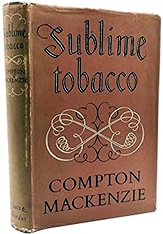Thu 7 Mar 2024
Reviewed by Dan Stumpf: COMPTON MACKENZIE – Sublime Tobacco.
Posted by Steve under General , Reviews[7] Comments
COMPTON MACKENZIE – Sublime Tobacco. Chatto and Windus, UK, hardcover, 1957.
Nowadays, when smoking is the eighth deadly sin, and smoking indoors constitutes a 4th degree misdemeanor, it’s oddly refreshing to read a book in praise of pure evil.

According to Wikipedia, Mackenzie was well-known in his day as “a writer of fiction, biography, histories and a memoir, as well as a cultural commentator, raconteur and lifelong Scottish nationalist,” and his name is occasionally resurrected today through the miracle of television, as the author of Whiskey Galore and Monarch of the Glen.
This, however, is something completely different (*). A history and personal memoir of the stuff we set on fire, stick in our mouths, and suck on it.
I should say at the outset, it’s mostly rather dull, then hasten to add that the part that ain’t dull is a really great read. And it comes at the beginning, so you don’t have to plow through a lot of soporifics to get there. Sublime Tobacco opens with a quietly rhapsodic mix of tales from the author’s own life and those of his puffing acquaintances: an autobiographical accolade to the stuff of coffin nails,
I was particularly charmed by the account of how he and his brother used to filch Daddy’s cigar butts from the ashtrays and smoke them in homemade pipes. When the old man got wise to it, he went for the time-honored cure-and-punishment: Gave them each a big cigar and ordered them to smoke it down to a stub. Mackenzie’s description of their delight and father’s dismay as the boys smoked cigars (at age 7 and 9) with pure enjoyment, then asked for another is a joy to read. And just as much fun, in a very different vein is his account of how he saved lives by calmly smoking two cigarettes outside the British Embassy in Athens during an anti-anglo riot.
Sublime segues smoothly from anecdotes to critical evaluation, taking time along the way to throw in personal bits of business involving the various and sundry means and methods of filling one’s lungs with noxious smoke. He concedes the convenience of the cigarette, lauds the luxury of the cigar, but like any intelligent man, he gives primacy of place to the Pipe.
Mackenzie’s catalogue of his own pipes, past and present, his analysis of form and function, shape and texture, and his nuanced descriptions of the tastes and aromas of the tobaccos of the world are vivid enough to discolor teeth in an avid reader. This is the work of a truly skillful writer, and his love of the subject is so evident and tender that I felt myself tearing up at times.
Or maybe smoke got in my eyes.
(*) Thanks, Monty Python
March 7th, 2024 at 9:51 pm
I was fascinated with Sylvia Scarlett, a film with Katharine Hepburn in the lead, and just awful, Brian Aherne and Cary Grant, beyond brilliant, and entertaining, he did not win the girl, but he won me. Directed by George Cukor it was and remains a colossal flop on every level, other than the one I mentioned above. For Grant it is a must-see, but I thought it was a must-read — not at all. What a bore.
March 7th, 2024 at 10:13 pm
https://en.wikipedia.org/wiki/Sylvia_Scarlett_(novel)
“The Early Life and Adventures of Sylvia Scarlett, often shortened to Sylvia Scarlett, is a 1918 novel by the British writer Compton Mackenzie. The heroine of the story had previously appeared in Mackenzie’s Sinister Street. It was followed by a sequel Sylvia and Michael in 1919.”
and for more on the author himself:
https://en.wikipedia.org/wiki/Compton_Mackenzie
March 8th, 2024 at 7:09 am
I have several of MacKenzie’s books buried in Mount TBR, including MONARCH OF THE GLEN, WHISKEY GALORE, and THE RIVAL MONSTERS (in which the Loch Ness Monster is supposedly struck by a flying saucer). After Dan’s review, I may get to them sooner than later.
March 8th, 2024 at 10:37 am
Mackenzie was also involved in intellgence work during Word War I and, thanks to his memoirs, was later tried for violating the Offical Secrets Act.
https://scalar.usc.edu/works/the-space-between-literature-and-culture-1914-1945/vol13_2017_kaufman
March 8th, 2024 at 8:28 pm
That book sounds like a great resource. I miss American tobacco culture; the rest of the world still smokes of course.
But I gotta say I never took pipes seriously; always thought them an affectation. I see I’m in error.
Mackenzie: still has an excellent reputation in English (Scottish?) letters. Member of a fine generation of intrepid scribes like Burton, Durrell, and Waugh who trotted the Empire so widely and wrote so engagingly.
Without looking it up, I’m trying to test my powers of recall. He has a sister who is also a famous author. Was it … ah! Ivy Compton-Burnett?
BTW I too admit fondness for Scarlett. Oy but what a howler. Box office poison for K-Hep for some time after. Similar to Bacall’s 3rd picture.
Final thought on the devil’s weed: I think its currently making a sneaking kind of comeback. But in grotesque fashion. Hideous little electronic gizmos everyone’s sucking on…
March 8th, 2024 at 10:04 pm
Yes, Lazy, those hideous little electronic gizmos do suck.
March 9th, 2024 at 10:29 am
Compton Mackenzie and Ivy Compton-Burnett weren’t related, Lazy. His sister Fay Compton was a well-known actress.
Compton Mackenzie himself had an interesting life. He wrote several volumes of autobiography, dozens of novels, was a Jacobite (which didn’t stop him accepting a knighthood), founded the Scottish National Party (despite being born in Hartlepool), went round buying islands and for all his successes was perpetually broke. Before WWI Henry James praised Sinister Street and Scott Fitzgerald’s early novels were influenced by him.